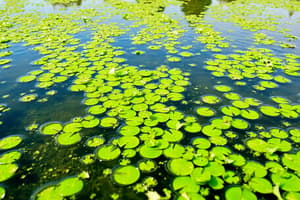Podcast
Questions and Answers
Match the fish symptom with the corresponding cause:
Match the fish symptom with the corresponding cause:
Hyperexcitability, neurological signs and stress = Ammonia Poisoning Dyspnea and stress, light tan to brown gills/blood = Nitrite Poisoning Dyspnea and stress Syndrome = Nitrate Poisoning Tremors and hyperactivity; dyspnea and acute stress response = Improper Hardness
Match the water condition with the appropriate treatment:
Match the water condition with the appropriate treatment:
Too Low (Too Acidic) pH = Appropriate percentage water change + Denitrification Too High (Too Alkaline) pH = Change water/ add buffer Improper Hardness = Change water/ add buffer Improper salinity = Not provided in the text
Match the environmental issue with the recommended action:
Match the environmental issue with the recommended action:
Environmental Hypoxia = Acute hypoxia: restore Oxygen level + monitor ammonia Temperature Stress = Restore proper temperature Temperature Stratification = Provide emergency aeration Not provided in the text = Not provided in the text
Match the fish symptom with the appropriate treatment:
Match the fish symptom with the appropriate treatment:
Match the poisoning type with its corresponding remedy:
Match the poisoning type with its corresponding remedy:
Match the symptom of improper salinity with its corresponding remedy:
Match the symptom of improper salinity with its corresponding remedy:
Match the following fish diseases with their symptoms:
Match the following fish diseases with their symptoms:
Match the following fish diseases with their characteristics:
Match the following fish diseases with their characteristics:
Match the following fish diseases with their pathogens:
Match the following fish diseases with their pathogens:
Match the following fish diseases with their effects:
Match the following fish diseases with their effects:
Match the parasitic infection with its characteristic symptoms:
Match the parasitic infection with its characteristic symptoms:
Match the type of treatment with the parasitic infection it targets:
Match the type of treatment with the parasitic infection it targets:
Match the ectoparasite with its associated symptoms:
Match the ectoparasite with its associated symptoms:
Match the disease with its effect on the gills of the organism:
Match the disease with its effect on the gills of the organism:
Match the symptom with the parasitic infection causing it:
Match the symptom with the parasitic infection causing it:
Match the treatment type with its effect on the organism:
Match the treatment type with its effect on the organism:
Match the disease with its typical sign:
Match the disease with its typical sign:
Match the treatment with the condition it is used for:
Match the treatment with the condition it is used for:
Match the infection with its characteristics:
Match the infection with its characteristics:
Match the water parameter change with its effect:
Match the water parameter change with its effect:
Match the infestation type with its description:
Match the infestation type with its description:
Match the disease with its characteristic lesions:
Match the disease with its characteristic lesions:
Flashcards are hidden until you start studying




